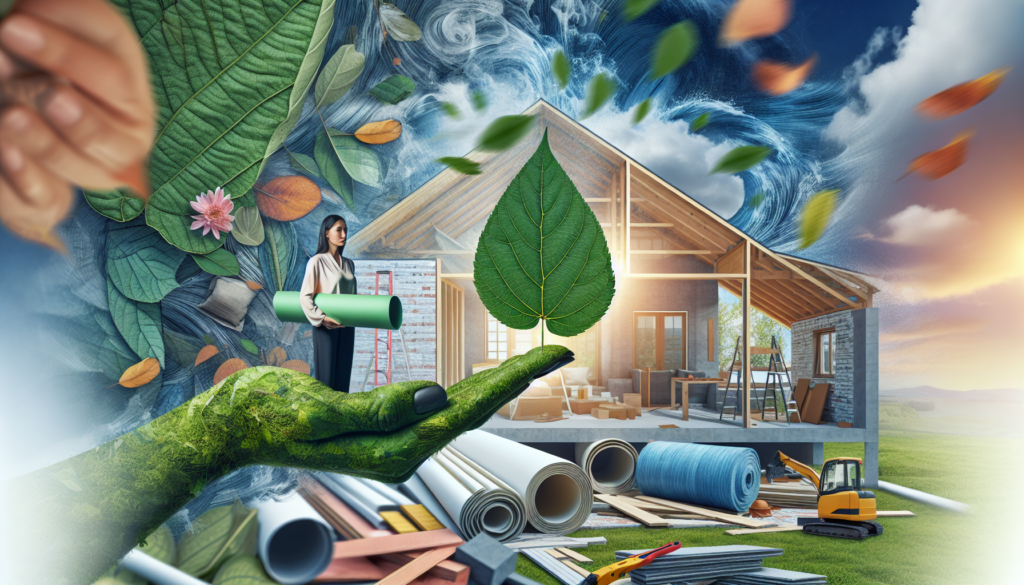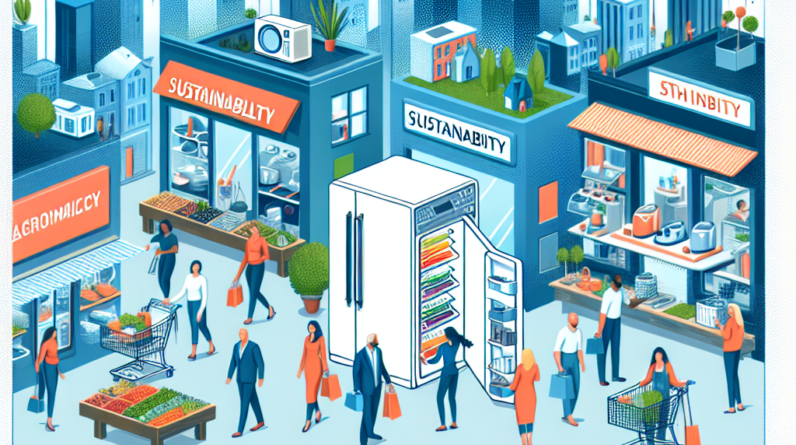
Are you looking for sustainable alternatives to traditional home insulation and roofing materials? In today’s ever-changing world, where environmental concerns are at the forefront, many homeowners are seeking eco-friendly options for their homes. Fortunately, there are a variety of sustainable alternatives available that not only help reduce the carbon footprint but also offer long-term benefits. From eco-friendly insulation made from recycled materials to innovative roofing solutions that harness renewable energy, this article explores the diverse options that are available to you. Discover how you can make a positive impact on the environment while improving the comfort and energy efficiency of your home.

Shop Sustainable Appliances on Amazon Here
Insulation Materials
R-value and Energy Efficiency
When it comes to choosing insulation materials for your home, one of the key factors to consider is the R-value. The R-value measures the insulation’s ability to resist heat flow, with higher values indicating better insulation. Opting for insulation with a high R-value will help improve the energy efficiency of your home by reducing heat loss in the winter and heat gain in the summer. By properly insulating your home, you can significantly reduce your energy consumption and lower your utility bills.
Fiberglass Insulation
Fiberglass insulation is a popular choice for many homeowners due to its affordability and widespread availability. It is made from fine glass fibers and offers good thermal performance. Fiberglass insulation is easy to install, non-combustible, and resistant to moisture, making it suitable for various areas of your home. However, it is essential to wear protective clothing and a mask during installation to minimize exposure to the small glass particles.
Cellulose Insulation
Cellulose insulation is an environmentally friendly option that is made from recycled paper products, usually treated to be fire-retardant. It offers excellent thermal performance and is particularly effective at reducing air leakage. Cellulose insulation can be blown into hard-to-reach areas, making it a great choice for retrofitting existing homes. However, it is important to note that cellulose insulation can settle over time, potentially reducing its effectiveness.
Spray Foam Insulation
Spray foam insulation is a versatile and high-performance option for home insulation. It is composed of two chemicals that combine to create a foam that expands and hardens, creating an airtight barrier. Spray foam insulation provides excellent thermal insulation, air sealing, and moisture control. It can be used in various applications, including walls, attics, and in crawl spaces. However, professional installation is usually required for spray foam insulation, as it requires special equipment and expertise.
Cotton Insulation
Cotton insulation is an eco-friendly alternative that is made from recycled cotton fibers. It offers good thermal performance and is a safer option for installation, as it does not release any harmful chemicals or irritants. Cotton insulation is typically available in batts or loose-fill form, making it suitable for both new construction and retrofitting projects. Additionally, cotton insulation has excellent sound-absorbing properties, making it an ideal choice for reducing noise pollution.
Sheep’s Wool Insulation
Sheep’s wool insulation is a natural and sustainable option that provides excellent thermal and acoustic insulation properties. It is derived from the wool of sheep and is often treated to be fire-resistant and insect-repellent. Sheep’s wool insulation is known for its breathability, allowing moisture to pass through without compromising its insulating abilities. It is also a renewable resource and biodegradable, making it an environmentally friendly choice.
Recycled Denim Insulation
Recycled denim insulation, also known as blue jean insulation, is made from post-consumer recycled denim scraps. It offers excellent thermal performance, sound absorption, and fire resistance. Recycled denim insulation is typically available in batts or loose-fill form, making it easy to install in walls, attics, and floors. It is a sustainable choice that helps reduce waste by repurposing old denim jeans.
Hemp Insulation
Hemp insulation is a natural and sustainable option that is made from the inner fibers of the hemp plant. It provides excellent thermal and acoustic insulation, as well as moisture resistance. Hemp insulation is known for its breathability, preventing the buildup of mold and mildew. It is also a renewable resource that can be grown without the use of harmful pesticides or herbicides.
Cork Insulation
Cork insulation is an eco-friendly choice that is made from the bark of cork oak trees. It offers excellent thermal insulation, sound absorption, and fire resistance. Cork insulation is a renewable resource, as the bark can be harvested without harming the tree. It is also biodegradable and recyclable, making it a sustainable option for home insulation.
Aerogel Insulation
Aerogel insulation is a highly efficient and advanced insulation material. It is composed of a gel-like substance that is mostly made up of air, resulting in an incredibly low thermal conductivity. Aerogel insulation is lightweight, durable, and offers superior thermal performance. While it is one of the most expensive insulation options, its exceptional insulation properties make it a popular choice for energy-conscious homeowners.
Roofing Materials
Metal Roofing
Metal roofing is a durable and long-lasting option that offers many advantages. It is resistant to extreme weather conditions, such as high winds and heavy snow, and can last for several decades with proper maintenance. Metal roofs are also highly reflective, reducing heat absorption and keeping your home cooler in hot climates. Additionally, metal roofing is recyclable, making it a sustainable choice for environmentally conscious homeowners.
Slate Roofing
Slate roofing is a luxurious and natural option that adds beauty and elegance to any home. It is made from thin sheets of stone and offers exceptional durability, often lasting a hundred years or more. Slate roofs are fire-resistant, waterproof, and highly resistant to wind damage. While slate roofing may be more costly than other options, its longevity and timeless appearance make it a worthwhile investment.
Clay Tiles
Clay tiles are a classic roofing material that has been used for centuries. They are known for their distinctive look and excellent durability. Clay tiles are resistant to fire, rot, and insects, making them a low-maintenance choice for homeowners. They also offer good thermal insulation and can reduce energy consumption. Clay tiles are available in a variety of colors and styles, allowing for customization to suit any architectural style.
Concrete Tiles
Concrete tiles are a versatile and affordable option for roofing. They are made from a mixture of cement, sand, and water, offering durability and long-lasting performance. Concrete tiles are resistant to fire and extreme weather conditions. They are also available in various styles and colors, allowing homeowners to achieve the desired aesthetic for their homes.
Wood Shingles and Shakes
Wood shingles and shakes are a timeless and natural choice for roofing. They provide a rustic, warm, and inviting look to any home. Wood shingles are machine-cut and have a more uniform appearance, while wood shakes are hand-split and have a more textured and rustic look. Wood roofing offers good insulation properties and can help regulate indoor temperatures. However, proper maintenance is essential to prevent issues such as rot and insect damage.
Recycled Rubber Roofing
Recycled rubber roofing, also known as rubber shingles, is an eco-friendly option that is made from recycled tires. It offers excellent durability and resistance to extreme weather conditions. Rubber roofing is lightweight, easy to install, and requires minimal maintenance. It also provides good insulation and soundproofing properties. Choosing recycled rubber roofing helps reduce waste by repurposing old tires.
Solar Reflective Roofing
Solar reflective roofing is designed to reflect sunlight and reduce heat absorption. It typically has a highly reflective surface that helps keep the roof and the interior of the home cooler. Solar reflective roofing can help reduce the energy needed for cooling during hot summer months, resulting in lower utility bills. It is available in various materials, including metal, asphalt, and tiles.
Green Roofs
Green roofs, also known as living roofs, are an innovative and environmentally friendly option for roofing. They consist of a layer of vegetation that is planted on top of a waterproof membrane. Green roofs provide numerous benefits, such as improved air quality, reduced stormwater runoff, and enhanced thermal insulation. They also create habitat for wildlife and can help mitigate the heat island effect in urban areas.
Thatched Roofs
Thatched roofs are traditional roofing systems that use dried vegetation, such as straw or reeds, to create a waterproof and durable covering. Thatching is a skilled craft that has been practiced for centuries. Thatched roofs offer excellent insulation properties, keeping homes cool in the summer and warm in the winter. They also have a unique and charming appearance, adding character to any home. However, thatched roofs require regular maintenance to prevent issues such as leaks and fire hazards.
Living Roofs
Living roofs, also known as rooftop gardens or roof terraces, are a growing trend in sustainable architecture. They involve the installation of a green space on the roof of a building, providing numerous environmental benefits. Living roofs help reduce stormwater runoff, improve air quality, and provide habitat for plants and animals. They also offer insulation properties, reducing energy consumption and creating a more comfortable indoor environment.
Cost and Affordability
Initial Installation Cost
When considering the cost of insulation and roofing materials, it is important to evaluate both the upfront installation costs and the long-term savings. The initial installation cost can vary significantly depending on the type of material, the size of the project, and other factors such as labor and location. Some materials may be more expensive upfront but offer higher durability and energy savings over time, making them a cost-effective investment.
Long-Term Savings
Choosing energy-efficient insulation and roofing materials can lead to substantial long-term savings. Proper insulation helps reduce the amount of energy needed to heat and cool your home, resulting in lower utility bills. Similarly, selecting roofing materials with good insulation properties and reflective surfaces can reduce the need for excessive air conditioning during hot summers. Over time, the energy savings can offset the initial installation cost, making sustainable alternatives more affordable in the long run.
Government and Rebate Programs
To encourage homeowners to invest in sustainable insulation and roofing materials, many governments and utility companies offer rebate programs and incentives. These programs provide financial assistance or tax credits for the purchase and installation of energy-efficient materials. It is worth researching the available programs in your area to take advantage of potential savings.
Return on Investment
Considering the return on investment is crucial when choosing insulation and roofing materials. While some sustainable alternatives may have a higher upfront cost, they often provide long-term benefits that outweigh the initial investment. Reduced energy consumption, lower maintenance costs, and increased property value can contribute to a significant return on investment over the lifespan of the materials.

Shop Sustainable Appliances on Amazon Here
Environmental Impact and Sustainability
Renewable and Recyclable Materials
Choosing insulation and roofing materials made from renewable or recyclable resources is an excellent way to minimize environmental impact. Materials like cellulose insulation, recycled denim insulation, hemp insulation, cork insulation, and rubber roofing made from recycled tires are all examples of sustainable options. By utilizing these materials, we reduce our reliance on non-renewable resources and contribute to a more circular economy.
Energy Efficiency
Opting for energy-efficient insulation and roofing materials helps reduce energy consumption and greenhouse gas emissions associated with heating and cooling homes. When homes are properly insulated and roofs have good thermal performance, less energy is required to maintain comfortable indoor temperatures. This not only saves money but also reduces our carbon footprint, mitigating the effects of climate change.
Reduced Carbon Footprint
By choosing sustainable alternatives for insulation and roofing, we can significantly reduce our carbon footprint. Traditional insulation materials, such as fiberglass, often require energy-intensive manufacturing processes, resulting in greenhouse gas emissions. In contrast, materials like sheep’s wool, cellulose, and hemp have a lower carbon footprint as they are renewable and require fewer resources to produce. Additionally, energy-efficient roofing materials, such as solar reflective roofing or green roofs, help reduce the energy needed for cooling, further decreasing carbon emissions.
Waste Reduction and Upcycling
Selecting insulation and roofing materials that utilize recycled or upcycled materials helps reduce waste and landfill impact. Materials like recycled denim insulation and rubber roofing made from old tires divert waste from the landfill and repurpose it for a useful application. By incorporating these materials into our homes, we contribute to a more sustainable and circular economy.
Harmful Emissions and VOCs
Traditional insulation and roofing materials may release volatile organic compounds (VOCs) and other harmful emissions into the air, compromising indoor air quality. By choosing environmentally friendly alternatives, such as cotton insulation or low-VOC spray foam insulation, we can minimize these emissions and create a healthier living environment for ourselves and our families. It is essential to consider the potential health impacts of the materials we choose and prioritize those that are non-toxic and low in harmful emissions.
Durability and Performance
Weather Resistance
One of the key factors to consider when selecting insulation and roofing materials is their ability to withstand various weather conditions. Materials that offer high resistance to wind, rain, snow, and UV radiation generally have a longer lifespan and require less frequent maintenance. Ensuring that insulation is properly sealed and roofing materials are installed according to manufacturer specifications helps enhance their weather resistance and overall performance.
Pest and Mold Resistance
To maintain a healthy and comfortable living environment, it is important to select insulation and roofing materials that are resistant to pests and mold. Moisture intrusion and inadequate ventilation can lead to mold growth, compromising indoor air quality. Insulation materials like spray foam, which provide an airtight barrier, can help prevent mold growth. Additionally, certain roofing materials, such as metal or slate, are less susceptible to pest infestations and provide effective protection against potential damage.
Fire Resistance
Choosing fire-resistant insulation and roofing materials is essential for home safety. Materials like fiberglass, cellulose, and sheep’s wool insulation are naturally resistant to fire. Similarly, roofing materials such as metal, slate, and clay tiles offer excellent fire resistance. It is crucial to carefully consider the fire rating and certification of the materials when making your selection.
Structural Strength
Insulation and roofing materials should contribute to the overall structural strength and stability of the home. Ensure that the chosen materials meet the required load-bearing and structural criteria. This is particularly important for roofing materials, as they are exposed to external forces such as wind and snow loads. Consulting with a professional structural engineer or contractor can help determine the compatibility and suitability of the materials for your specific project.
Maintenance and Repairs
Regular maintenance and prompt repairs are crucial for prolonging the lifespan of insulation and roofing materials. While some materials may require minimal maintenance, others may need periodic inspections, cleaning, or treatments to ensure their optimal performance. It is important to follow the manufacturer’s maintenance guidelines and address any issues promptly to prevent further damage and maintain the integrity of the materials.
Health and Indoor Air Quality
Allergen and Chemical Sensitivities
For individuals with allergies or chemical sensitivities, choosing insulation and roofing materials that are low in allergens and harmful chemicals is essential. Materials like cellulose insulation, cotton insulation, and sheep’s wool insulation are generally safer options, as they do not release toxins or irritants into the air. Additionally, selecting roofing materials that have low VOC emissions helps maintain good indoor air quality.
Air Ventilation and Moisture Control
Proper ventilation and moisture control are crucial for maintaining a healthy indoor environment. Insulation materials that allow for adequate airflow, such as cellulose and wool, help prevent moisture buildup and mitigate the risk of mold growth. Additionally, ensuring proper attic ventilation and using roofing materials that allow for moisture escape can help regulate humidity levels and minimize the potential for condensation-related issues.
Noise Reduction
Insulation materials, especially those with good sound-absorbing properties, can help reduce noise pollution from external sources and improve indoor acoustics. Materials like cotton insulation, cellulose insulation, and certain types of foam insulation provide excellent sound insulation properties, creating a more peaceful and comfortable living environment.
Indoor Temperature Regulation
Choosing insulation and roofing materials with good thermal performance helps regulate indoor temperatures and maintain a comfortable living space. Insulation materials like spray foam, cellulose, and sheep’s wool provide effective thermal insulation, reducing heat transfer and minimizing temperature fluctuations. Similarly, selecting roofing materials with good insulation properties, such as metal or clay tiles, helps prevent excessive heat absorption, keeping the interior cooler in hot climates.
Installation Process
DIY vs Professional Installation
When considering insulation and roofing projects, it is essential to evaluate whether a do-it-yourself (DIY) installation or professional installation is the right choice for you. Simple insulation projects, such as installing batts or rolls, can often be DIY-friendly. However, more complex installations, such as spray foam or green roofs, generally require professional expertise and specialized equipment. Hiring a professional ensures that the materials are installed correctly, maximizing their effectiveness and longevity.
Compatibility with Existing Structures
Before selecting insulation and roofing materials, it is important to assess the compatibility of the materials with your existing structures. Consider factors such as load-bearing capacity, structural requirements, and potential interaction with other elements of the building envelope. Consulting with a professional contractor or engineer can help determine the most suitable materials and ensure they are compatible with your specific project.
Installation Techniques and Considerations
Different insulation and roofing materials require specific installation techniques and considerations. For example, fiberglass insulation needs to be properly cut and fitted to fill cavities, while spray foam insulation requires precise application and curing time. Similarly, roofing materials like metal or clay tiles may require specialized tools and techniques for proper installation. It is crucial to carefully follow the manufacturer’s installation guidelines and consult with professionals if needed to ensure a successful installation.
Aesthetics and Design
Architectural Styles
The choice of insulation and roofing materials can greatly impact the aesthetics and design of a home. Each material has its unique appearance and characteristics that can complement different architectural styles. For example, slate roofing beautifully complements traditional or historical homes, while metal roofing offers a sleek and modern look. Consider the architectural style of your home and select materials that enhance its overall design and curb appeal.
Color and Texture Options
Insulation and roofing materials come in a variety of colors and textures, allowing homeowners to customize their appearance. For example, shingles and shakes made from wood can provide a natural and textured look, while metal roofing is available in various colors and finishes. Choosing materials that align with your aesthetic preferences and harmonize with the surrounding environment can enhance the visual impact of your home.
Visual Impact on Property Value
Investing in high-quality and aesthetically pleasing insulation and roofing materials can positively impact the value of your property. Materials that offer durability, energy efficiency, and visual appeal can make your home more attractive to potential buyers. Additionally, sustainable alternatives may resonate with environmentally conscious buyers, further increasing the appeal and market value of your property.
Certifications and Standards
ENERGY STAR
The ENERGY STAR certification is a widely recognized symbol of energy efficiency. Products with the ENERGY STAR label, including insulation and roofing materials, meet rigorous standards for energy performance and efficiency. Choosing materials that are ENERGY STAR certified ensures that they have been independently tested and verified to deliver optimal energy savings.
LEED Certification
LEED (Leadership in Energy and Environmental Design) certification provides a comprehensive framework for sustainable building design, construction, and operation. LEED-certified buildings prioritize energy efficiency, water conservation, indoor environmental quality, and resource efficiency. Choosing insulation and roofing materials that meet LEED requirements can contribute to a more sustainable and environmentally friendly home.
GreenGuard Certification
GreenGuard certification verifies that products meet stringent standards for low chemical emissions and contribute to healthier indoor environments. Insulation and roofing materials with GreenGuard certification help maintain good indoor air quality by minimizing the release of VOCs and other harmful pollutants. Choosing certified materials promotes a healthier living environment for occupants.
National Green Building Standard
The National Green Building Standard (NGBS) provides guidelines and criteria for sustainable residential construction, including insulation and roofing materials. NGBS-certified products meet specific performance requirements for energy efficiency, resource conservation, and overall sustainability. Opting for materials that conform to the NGBS helps ensure that your insulation and roofing choices align with recognized industry standards for green building.
Recycling and Disposal
Recyclability of Materials
Considering the end-of-life options for insulation and roofing materials is crucial to minimize waste and environmental impact. Some materials, such as cellulose insulation, recycled denim insulation, and rubber roofing made from recycled tires, are recyclable at the end of their lifespan. Choosing recyclable materials promotes a more circular economy and reduces the demand for new raw materials.
Responsible Disposal and Landfill Impact
For materials that are not recyclable, it is important to consider responsible disposal options to minimize their impact on landfills. Properly disposing of insulation and roofing materials according to local regulations ensures that they do not contribute to landfill waste and potential environmental contamination. Work with local waste management facilities to determine the appropriate disposal methods for your specific materials.
In conclusion, there are various sustainable alternatives available for home insulation and roofing materials. By considering factors such as R-value, energy efficiency, environmental impact, durability, health, installation process, aesthetics, and certifications, you can make informed decisions that enhance the sustainability of your home while meeting your specific needs. Whether it’s choosing cellulose insulation for its recycled content, selecting solar reflective roofing for energy savings, or opting for recycled rubber roofing to reduce waste, each sustainable choice contributes to a greener and more sustainable future. Take the time to research and explore the wide range of options available, and work with trusted professionals to ensure that your insulation and roofing choices align with your values and goals.





